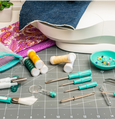
Bundle & Save Shop your favorite Heavy Duty machines bundled with must-have accessories—all at a price that’s hard to beat.

🏷️HD4411 Now Just $199.99! Limited time offer — the HD411 is $199.99 and up to 40% off all Heavy Duty machines!
- Machine Category
- Sewing
- Embroidery
- Serger
- Heavy Duty
- Refurbished
- MOMENTO™ Cutting Machine
- MOMENTO™ Heat Presses
- View All

Machine Finder Find the right machine for your project.

View all machines Sewing, Embroidery, Fabric Cutting machines and more!

🏷️HD4411 Now Just $199.99! Limited time offer — the HD411 is $199.99 and up to 40% off all Heavy Duty machines!

Extra Savings on Refurbs! SAVE an extra 15% on refurbished machines. Limited quantities; grab yours before they’re gone!
- Accessories
- Bobbins
- Extension Tables
- Presser Feet/Attachments
- Embroidery Hoops
- MOMENTO™ Accessories
- View All
- Notions
- Needles
- Scissors
- Sewing Kits & Aids
- Quilting Supplies
- Sewing Supplies
- Irons
- Steamers / Steam Presses
- Stabilizers
- Bags / Cases
- Dress Forms
- Thread
- View All

Accessory Finder Find the right accessory for your machine.

View All Accessories Huge selection of sewing solutions and supplies.
- Ways to Save
- Sewing Machine Trade In
- Top-Rated
- Clearance
- Bundle & Save
- New Markdowns
- Deals Under $50
- Deals Under $100
- View All

SAVE Up To 40% Enjoy up to 40% Off machines, and SAVE 30% on select accessories.

🏷️HD4411 Now Just $199.99! Limited time offer — the HD411 is $199.99 and up to 40% off all Heavy Duty machines!

Additional 10% Off Limited stock available. Shop now before it's too late!

Extra Savings on Refurbs! SAVE an extra 15% on refurbished machines. Limited quantities; grab yours before they’re gone!
- Gift Guides
- Stocking Stuffers
- Budget-Friendly Machines
- Gift Finder
- Gifts for Sewists
- Gifts for Quilters
- Gifts for Embroidery
- Gift Cards
- Holiday Gift Guide

Find the Perfect Gift Ready to make gifting easy? Take the quiz to find the perfect gift.

Machine Finder Find the right machine for your project.

Accessory Finder Find the right accessory for your machine.

Explore our Gift Guide The Ultimate Holiday Gift Guide for Sewists, Quilters & Embroiderers from SINGER®, PFAFF® & HUSQVARNA® VIKING®.
